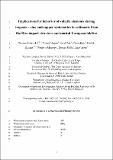Files in this item
Implications for behavior of volatile elements during impacts—Zinc and copper systematics in sediments from the Ries impact structure and central European tektites
Item metadata
| dc.contributor.author | Rodovská, Zuzana | |
| dc.contributor.author | Magna, Tomáš | |
| dc.contributor.author | Žák, Karel | |
| dc.contributor.author | Kato, Chizu | |
| dc.contributor.author | Savage, Paul S. | |
| dc.contributor.author | Moynier, Frédéric | |
| dc.contributor.author | Skála, Roman | |
| dc.contributor.author | Ježek, Josef | |
| dc.date.accessioned | 2018-07-27T23:34:28Z | |
| dc.date.available | 2018-07-27T23:34:28Z | |
| dc.date.issued | 2017-10 | |
| dc.identifier | 250568637 | |
| dc.identifier | 1380048c-789e-4c1e-8129-7d5e5e4b2f3d | |
| dc.identifier | 85026364214 | |
| dc.identifier | 000412173600007 | |
| dc.identifier.citation | Rodovská , Z , Magna , T , Žák , K , Kato , C , Savage , P S , Moynier , F , Skála , R & Ježek , J 2017 , ' Implications for behavior of volatile elements during impacts—Zinc and copper systematics in sediments from the Ries impact structure and central European tektites ' , Meteoritics & Planetary Science , vol. 52 , no. 10 , pp. 2178-2192 . https://doi.org/10.1111/maps.12922 | en |
| dc.identifier.issn | 1945-5100 | |
| dc.identifier.other | Bibtex: urn:e2fc01425eac63de21f7d8e19bedf2fb | |
| dc.identifier.other | ORCID: /0000-0001-8464-0264/work/64034630 | |
| dc.identifier.uri | https://hdl.handle.net/10023/15727 | |
| dc.description | This study has been funded through the Czech Science Foundation project 13-22351S. Paul Savage was supported by the Marie Curie IOF ‘Isovolc.’ Frederic Moynier is grateful to the European Research Council under the European Community's H2020 framework program/ERC grant agreement # 637503 (Pristine) and the Agence Nationale de la Recherche for a chaire d'Excellence Sorbonne Paris Cité (IDEX13C445), and for the UnivEarthS Labex program (ANR-10-LABX-0023 and ANR-11-IDEX-0005-02). Parts of this work were supported by IPGP multidisciplinary program PARI, and by Region Île-de-France SESAME Grant no. 12015908. | en |
| dc.description.abstract | Moldavites are tektites genetically related to the Ries impact structure, located in Central Europe, but the source materials and the processes related to the chemical fractionation of moldavites are not fully constrained. To further understand moldavite genesis, the Cu and Zn abundances and isotope compositions were measured in a suite of tektites from four different substrewn fields (South Bohemia, Moravia, Cheb Basin, Lusatia) and chemically diverse sediments from the surroundings of the Ries impact structure. Moldavites are slightly depleted in Zn (~10–20%) and distinctly depleted in Cu (>90%) relative to supposed sedimentary precursors. Moreover, the moldavites show a wide range in δ66Zn values between 1.7 and 3.7‰ (relative to JMC 3-0749 Lyon) and δ65Cu values between 1.6 and 12.5‰ (relative to NIST SRM 976) and are thus enriched in heavy isotopes relative to their possible parent sedimentary sources (δ66Zn = −0.07 to +0.64‰; δ65Cu = −0.4 to +0.7‰). In particular, the Cheb Basin moldavites show some of the highest δ65Cu values (up to 12.5‰) ever observed in natural samples. The relative magnitude of isotope fractionation for Cu and Zn seen here is opposite to oxygen-poor environments such as the Moon where Zn is significantly more isotopically fractionated than Cu. One possibility is that monovalent Cu diffuses faster than divalent Zn in the reduced melt and diffusion will not affect the extent of Zn isotope fractionation. These observations imply that the capability of forming a redox environment may aid in volatilizing some elements, accompanied by isotope fractionation, during the impact process. The greater extent of elemental depletion, coupled with isotope fractionation of more refractory Cu relative to Zn, may also hinge on the presence of carbonyl species of transition metals and electromagnetic charge, which could exist in the impact-induced high-velocity jet of vapor and melts. | |
| dc.format.extent | 406870 | |
| dc.language.iso | eng | |
| dc.relation.ispartof | Meteoritics & Planetary Science | en |
| dc.subject | Zinc isotopes | en |
| dc.subject | Copper isotopes | en |
| dc.subject | Tektites | en |
| dc.subject | Ries crater | en |
| dc.subject | Ries area sediments | en |
| dc.subject | Isotope fractionation | en |
| dc.subject | Impact | en |
| dc.subject | Volatile loss | en |
| dc.subject | QE Geology | en |
| dc.subject | QC Physics | en |
| dc.subject | NDAS | en |
| dc.subject.lcc | QE | en |
| dc.subject.lcc | QC | en |
| dc.title | Implications for behavior of volatile elements during impacts—Zinc and copper systematics in sediments from the Ries impact structure and central European tektites | en |
| dc.type | Journal article | en |
| dc.contributor.institution | University of St Andrews. St Andrews Centre for Exoplanet Science | en |
| dc.contributor.institution | University of St Andrews. Earth and Environmental Sciences | en |
| dc.contributor.institution | University of St Andrews. St Andrews Isotope Geochemistry | en |
| dc.identifier.doi | https://doi.org/10.1111/maps.12922 | |
| dc.description.status | Peer reviewed | en |
| dc.date.embargoedUntil | 2018-07-27 |
This item appears in the following Collection(s)
Items in the St Andrews Research Repository are protected by copyright, with all rights reserved, unless otherwise indicated.

